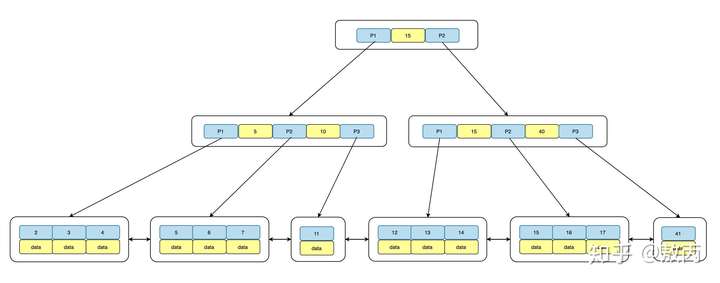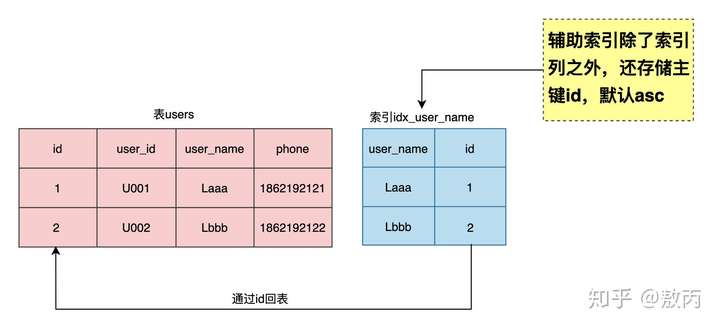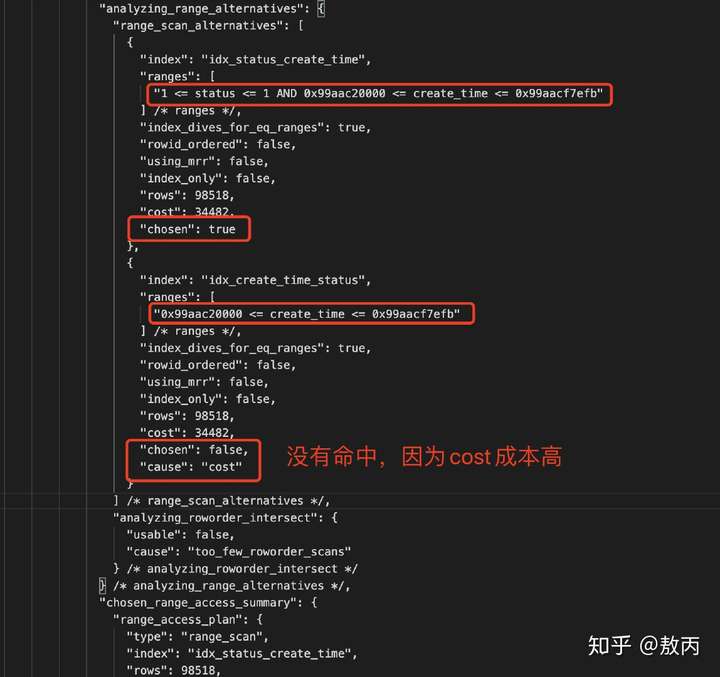[TOC]
## **MySQL中的索引**
MySQL中的InnoDB引擎使用B+Tree结构来存储索引,可以尽量减少数据查询时磁盘IO次数,同时树的高度直接影响了查询的性能,一般树的高度维持在 3~4 层。
B+Tree由三部分组成:根root、枝branch以及Leaf叶子,其中root和branch不存储数据,只存储指针地址,数据全部存储在Leaf Node,同时Leaf Node之间用双向链表链接,结构如下:

从上面可以看到,每个Leaf Node是三部分组成的,即前驱指针p\_prev,数据data以及后继指针p\_next,同时数据data是有序的,默认是升序ASC,分布在B+tree右边的键值总是大于左边的,同时从root到每个Leaf的距离是相等的,也就是访问任何一个Leaf Node需要的IO是一样的,即索引树的高度Level + 1次IO操作。
我们可以将MySQL中的索引可以看成一张小表,占用磁盘空间,创建索引的过程其实就是按照索引列排序的过程,先在sort\_buffer\_size进行排序,如果排序的数据量大,sort\_buffer\_size容量不下,就需要通过临时文件来排序,最重要的是通过索引可以避免排序操作(distinct,group by,order by)。
### **聚集索引**
MySQL中的表是IOT(Index Organization Table,索引组织表),数据按照主键id顺序存储(逻辑上是连续,物理上不连续),而且主键id是聚集索引(clustered index),存储着整行数据,如果没有显示的指定主键,MySQL会将所有的列组合起来构造一个row\_id作为primary key,例如表users(id, user\_id, user\_name, phone, primary key(id)),id是聚集索引,存储了id, user\_id, user\_name, phone整行的数据。
### **辅助索引**

辅助索引也称为二级索引,索引中除了存储索引列外,还存储了主键id,对于user\_name的索引idx\_user\_name(user\_name)而言,其实等价于idx\_user\_name(user\_name, id),MySQL会自动在辅助索引的最后添加上主键id,熟悉Oracle数据库的都知道,索引里除了索引列还存储了row\_id(代表数据的物理位置,由四部分组成:对象编号+数据文件号+数据块号+数据行号),我们在创建辅助索引也可以显示添加主键id。
~~~text
-- 创建user_name列上的索引
mysql> create index idx_user_name on users(user_name);
-- 显示添加主键id创建索引
mysql> create index idx_user_name_id on users(user_name,id);
-- 对比两个索引的统计数据
mysql> select a.space as tbl_spaceid, a.table_id, a.name as table_name, row_format, space_type, b.index_id , b.name as index_name, n_fields, page_no, b.type as index_type from information_schema.INNODB_TABLES a left join information_schema.INNODB_INDEXES b on a.table_id =b.table_id where a.name = 'test/users';
+-------------+----------+------------+------------+------------+----------+------------------+----------+------
| tbl_spaceid | table_id | table_name | row_format | space_type | index_id | index_name | n_fields | page_no | index_type |
+-------------+----------+------------+------------+------------+----------+------------------+----------+------
| 518 | 1586 | test/users | Dynamic | Single | 1254 | PRIMARY | 9 | 4 | 3 |
| 518 | 1586 | test/users | Dynamic | Single | 4003 | idx_user_name | 2 | 5 | 0 |
| 518 | 1586 | test/users | Dynamic | Single | 4004 | idx_user_name_id | 2 | 45 | 0 |
mysql> select index_name, last_update, stat_name, stat_value, stat_description from mysql.innodb_index_stats where index_name in ('idx_user_name','idx_user_name_id');
+------------------+---------------------+--------------+------------+-----------------------------------+
| index_name | last_update | stat_name | stat_value | stat_description |
+------------------+---------------------+--------------+------------+-----------------------------------+
| idx_user_name | 2021-01-02 17:14:48 | n_leaf_pages | 1358 | Number of leaf pages in the index |
| idx_user_name | 2021-01-02 17:14:48 | size | 1572 | Number of pages in the index |
| idx_user_name_id | 2021-01-02 17:14:48 | n_leaf_pages | 1358 | Number of leaf pages in the index |
| idx_user_name_id | 2021-01-02 17:14:48 | size | 1572 | Number of pages in the index |
~~~
对比一下两个索引的结果,n\_fields表示索引中的列数,n\_leaf\_pages表示索引中的叶子页数,size表示索引中的总页数,通过数据比对就可以看到,辅助索引中确实包含了主键id,也说明了这两个索引时完全一致。
| Index\_name | n\_fields | n\_leaf\_pages | size |
| --- | --- | --- | --- |
### **索引回表**
上面证明了辅助索引包含主键id,如果通过辅助索引列去过滤数据有可能需要回表,举个例子:业务需要通过用户名user\_name去查询用户表users的信息,业务接口对应的SQL:
~~~text
select user_id, user_name, phone from users where user_name = 'Laaa';
~~~
我们知道,对于索引idx\_user\_name而言,其实就是一个小表idx\_user\_name(user\_name, id),如果只查询索引中的列,只需要扫描索引就能获取到所需数据,是不需要回表的,如下SQL语句:
SQL 1:`select id, user_name from users where user_name = 'Laaa';`
**SQL 2:**`select id from users where user_name = 'Laaa';`
~~~text
mysql> explain select id, name from users where name = 'Laaa';
+----+-------------+-------+------------+------+---------------+---------------+---------+-------+------+-------
| id | select_type | table | partitions | type | possible_keys | key | key_len | ref | rows | filtered | Extra |
+----+-------------+-------+------------+------+---------------+---------------+---------+-------+------+-------
| 1 | SIMPLE | users | NULL | ref | idx_user_name | idx_user_name | 82 | const | 1 | 100.00 | Using index |
mysql> explain select id from users where name = 'Laaa';
+----+-------------+-------+------------+------+---------------+---------------+---------+-------+------+-------
| id | select_type | table | partitions | type | possible_keys | key | key_len | ref | rows | filtered | Extra |
+----+-------------+-------+------------+------+---------------+---------------+---------+-------+------+-------
| 1 | SIMPLE | users | NULL | ref | idx_user_name | idx_user_name | 82 | const | 1 | 100.00 | Using index |
~~~
SQL 1和SQL 2的执行计划中的Extra=**Using index**表示使用覆盖索引扫描,不需要回表,再来看上面的业务SQL:
`select user_id, user_name, phone from users where user_name = 'Laaa';`
可以看到select后面的user\_id,phone列不在索引idx\_user\_name中,就需要通过主键id进行回表查找,MySQL内部分如下两个阶段处理:
**Section 1**:`select **id** from users where user_name = 'Laaa'`//id = 100101
**Section 2:**`select user_id, user_name, phone from users where id`\= 100101;
将**Section 2**的操作称为回表,即通过辅助索引中的主键id去原表中查找数据。
### **索引高度**
MySQL的索引时B+tree结构,即使表里有上亿条数据,索引的高度都不会很高,通常维持在3-4层左右,我来计算下索引idx\_name的高度,从上面知道索引信息:index\_id = 4003, page\_no = 5,它的偏移量offset就是page\_no x innodo\_page\_size + 64 = 81984,通过hexdump进行查看
~~~text
$hexdump -s 81984 -n 10 /usr/local/var/mysql/test/users.ibd
0014040 00 02 00 00 00 00 00 00 0f a3
001404a
~~~
其中索引的PAGE\_LEVEL为00,即idx\_user\_name索引高度为1,0f a3 代表索引编号,转换为十进制是4003,正是index\_id。
### **数据扫描方式**
**全表扫描**
从左到右依次扫描整个B+Tree获取数据,扫描整个表数据,IO开销大,速度慢,锁等严重,影响MySQL的并发。
对于OLAP的业务场景,需要扫描返回大量数据,这时候全表扫描的顺序IO效率更高。
**索引扫描**
通常来讲索引比表小,扫描的数据量小,消耗的IO少,执行速度块,几乎没有锁等,能够提高MySQL的并发。
对于OLTP系统,希望所有的SQL都能命中合适的索引总是美好的。
主要区别就是扫描数据量大小以及IO的操作,全表扫描是顺序IO,索引扫描是随机IO,MySQL对此做了优化,增加了change buffer特性来提高IO性能。
### **索引优化案例**
**分页查询优化**
业务要根据时间范围查询交易记录,接口原始的SQL如下:
~~~text
select * from trade_info where status = 0 and create_time >= '2020-10-01 00:00:00' and create_time <= '2020-10-07 23:59:59' order by id desc limit 102120, 20;
~~~
表trade\_info上有索引idx\_status\_create\_time(status,create\_time),通过上面分析知道,等价于索引\*\*(status,create\_time,id)\*\*,对于典型的分页limit m, n来说,越往后翻页越慢,也就是m越大会越慢,因为要定位m位置需要扫描的数据越来越多,导致IO开销比较大,这里可以利用辅助索引的覆盖扫描来进行优化,先获取id,这一步就是索引覆盖扫描,不需要回表,然后通过id跟原表trade\_info进行关联,改写后的SQL如下:
~~~text
select * from trade_info a ,
(select id from trade_info where status = 0 and create_time >= '2020-10-01 00:00:00' and create_time <= '2020-10-07 23:59:59' order by id desc limit 102120, 20) as b //这一步走的是索引覆盖扫描,不需要回表
where a.id = b.id;
~~~
很多同学只知道这样写效率高,但是未必知道为什么要这样改写,理解索引特性对编写高质量的SQL尤为重要。
**分而治之总是不错的**
营销系统有一批过期的优惠卷要失效,核心SQL如下:
~~~text
-- 需要更新的数据量500w
update coupons set status = 1 where status =0 and create_time >= '2020-10-01 00:00:00' and create_time <= '2020-10-07 23:59:59';
~~~
在Oracle里更新500w数据是很快,因为可以利用多个cpu core去执行,但是MySQL就需要注意了,一个SQL只能使用一个cpu core去处理,如果SQL很复杂或执行很慢,就会阻塞后面的SQL请求,造成活动连接数暴增,MySQL CPU 100%,相应的接口Timeout,同时对于主从复制架构,而且做了业务读写分离,更新500w数据需要5分钟,Master上执行了5分钟,binlog传到了slave也需要执行5分钟,那就是Slave延迟5分钟,在这期间会造成业务脏数据,比如重复下单等。
**优化思路:先获取where条件中的最小id和最大id,然后分批次去更新,每个批次1000条,这样既能快速完成更新,又能保证主从复制不会出现延迟。**
**优化如下:**
1. 先获取要更新的数据范围内的最小id和最大id(表没有物理delete,所以id是连续的)
~~~text
mysql> explain select min(id) min_id, max(id) max_id from coupons where status =0 and create_time >= '2020-10-01 00:00:00' and create_time <= '2020-10-07 23:59:59';
+----+-------------+-------+------------+-------+------------------------+------------------------+---------+---
| id | select_type | table | partitions | type | possible_keys | key | key_len | ref | rows | filtered | Extra |
+----+-------------+-------+------------+-------+------------------------+------------------------+---------+---
| 1 | SIMPLE | users | NULL | range | idx_status_create_time | idx_status_create_time | 6 | NULL | 180300 | 100.00 | Using where; Using index |
~~~
Extra=Using where; Using index使用了索引idx\_status\_create\_time,同时需要的数据都在索引中能找到,所以不需要回表查询数据。
1. 以每次1000条commit一次进行循环update,主要代码如下:
~~~text
current_id = min_id;
for current_id < max_id do
update coupons set status = 1 where id >=current_id and id <= current_id + 1000; //通过主键id更新1000条很快
commit;
current_id += 1000;
done
~~~
这两个案例告诉我们,要充分利用辅助索引包含主键id的特性,先通过索引获取主键id走覆盖索引扫描,不需要回表,然后再通过id去关联操作是高效的,同时根据MySQL的特性使用分而治之的思想既能高效完成操作,又能避免主从复制延迟产生的业务数据混乱。
## **MySQL索引设计**
熟悉了索引的特性之后,就可以在业务开发过程中设计高质量的索引,降低接口的响应时间。
### **前缀索引**
对于使用REDUNDANT或者COMPACT格式的InnoDB表,索引键前缀长度限制为767字节。如果TEXT或VARCHAR列的列前缀索引超过191个字符,则可能会达到此限制,假定为utf8mb4字符集,每个字符最多4个字节。
可以通过设置参数innodb\_large\_prefix来开启或禁用索引前缀长度的限制,即是设置为OFF,索引虽然可以创建成功,也会有一个警告,主要是因为index size会很大,效率大量的IO的操作,即使MySQL优化器命中了该索引,效率也不会很高。
~~~text
-- 设置innodb_large_prefix=OFF禁用索引前缀限制,虽然可以创建成功,但是有警告。
mysql> create index idx_nickname on users(nickname); // `nickname` varchar(255)
Records: 0 Duplicates: 0 Warnings: 1
mysql> show warnings;
+---------+------+---------------------------------------------------------+
| Level | Code | Message |
+---------+------+---------------------------------------------------------+
| Warning | 1071 | Specified key was too long; max key length is 767 bytes |
~~~
业务发展初期,为了快速实现功能,对一些数据表字段的长度定义都比较宽松,比如用户表users的昵称nickname定义为varchar(128),而且有业务接口需要通过nickname查询,系统运行了一段时间之后,查询users表最大的nickname长度为30,这个时候就可以创建前缀索引来减小索引的长度提升性能。
~~~text
-- `nickname` varchar(128) DEFAULT NULL定义的执行计划
mysql> explain select * from users where nickname = 'Laaa';
+----+-------------+-------+------------+------+---------------+--------------+---------+-------+------+--------
| id | select_type | table | partitions | type | possible_keys | key | key_len | ref | rows | filtered | Extra |
+----+-------------+-------+------------+------+---------------+--------------+---------+-------+------+--------
| 1 | SIMPLE | users | NULL | ref | idx_nickname | idx_nickname | 515 | const | 1 | 100.00 | NULL |
~~~
key\_len=515,由于表和列都是utf8mb4字符集,每个字符占4个字节,变长数据类型+2Bytes,允许NULL额外+1Bytes,即128 x 4 + 2 + 1 = 515Bytes。创建前缀索引,前缀长度也可以不是当前表的数据列最大值,应该是区分度最高的那部分长度,一般能达到90%以上即可,例如email字段存储都是类似这样的值xxxx@yyy.com,前缀索引的最大长度可以是xxxx这部分的最大长度即可。
~~~text
-- 创建前缀索引,前缀长度为30
mysql> create index idx_nickname_part on users(nickname(30));
-- 查看执行计划
mysql> explain select * from users where nickname = 'Laaa';
+----+-------------+-------+------------+------+--------------------------------+-------------------+---------+-
| id | select_type | table | partitions | type | possible_keys | key | key_len | ref | rows | filtered | Extra |
+----+-------------+-------+------------+------+--------------------------------+-------------------+---------+-
| 1 | SIMPLE | users | NULL | ref | idx_nickname_part,idx_nickname | idx_nickname_part | 123 | const | 1 | 100.00 | Using where |
~~~
可以看到优化器选择了前缀索引,索引长度为123,即30 x 4 + 2 + 1 = 123 Bytes,大小不到原来的四分之。
**前缀索引虽然可以减小索引的大小,但是不能消除排序。**
~~~text
mysql> explain select gender,count(*) from users where nickname like 'User100%' group by nickname limit 10;
+----+-------------+-------+------------+-------+--------------------------------+--------------+---------+-----
| id | select_type | table | partitions | type | possible_keys | key | key_len | ref | rows | filtered | Extra |
+----+-------------+-------+------------+-------+--------------------------------+--------------+---------+-----
| 1 | SIMPLE | users | NULL | range | idx_nickname_part,idx_nickname | idx_nickname | 515 | NULL | 899 | 100.00 | Using index condition |
--可以看到Extra= Using index condition表示使用了索引,但是需要回表查询数据,没有发生排序操作。
mysql> explain select gender,count(*) from users where nickname like 'User100%' group by nickname limit 10;
+----+-------------+-------+------------+-------+-------------------+-------------------+---------+------+------
| id | select_type | table | partitions | type | possible_keys | key | key_len | ref | rows | filtered | Extra |
+----+-------------+-------+------------+-------+-------------------+-------------------+---------+------+------
| 1 | SIMPLE | users | NULL | range | idx_nickname_part | idx_nickname_part | 123 | NULL | 899 | 100.00 | Using where; Using temporary |
--可以看到Extra= Using where; Using temporaryn表示在使用了索引的情况下,需要回表去查询所需的数据,同时发生了排序操作。
~~~
### **复合索引**
在单列索引不能很好的过滤数据的时候,可以结合where条件中其他字段来创建复合索引,更好的去过滤数据,减少IO的扫描次数,举个例子:业务需要按照时间段来查询交易记录,有如下的SQL:
~~~text
select * from trade_info where status = 1 and create_time >= '2020-10-01 00:00:00' and create_time <= '2020-10-07 23:59:59';
~~~
开发同学根据以往复合索引的设计的经验:**唯一值多选择性好的列作为复合索引的前导列**,所以创建复合索idx\_create\_time\_status是高效的,因为create\_time是一秒一个值,唯一值很多,选择性很好,而status只有离散的6个值,所以认为这样创建是没问题的,**但是这个经验只适合于等值条件过滤,不适合有范围条件过滤的情况**,例如idx\_user\_id\_status(user\_id,status)这个是没问题的,但是对于包含有create\_time范围的复合索引来说,就不适应了,我们来看下这两种不同索引顺序的差异,即idx\_status\_create\_time和idx\_create\_time\_status。
~~~text
-- 分别创建两种不同的复合索引
mysql> create index idx_status_create_time on trade_info(status, create_time);
mysql> create index idx_create_time_status on trade_info(create_time,status);
-- 查看SQL的执行计划
mysql> explain select * from users where status = 1 and create_time >='2021-10-01 00:00:00' and create_time <= '2021-10-07 23:59:59';
+----+-------------+-------+------------+-------+-----------------------------------------------+---------------
| id | select_type | table | partitions | type | possible_keys | key | key_len | ref | rows | filtered | Extra |
+----+-------------+-------+------------+-------+-----------------------------------------------+---------------
| 1 | SIMPLE | trade_info | NULL | range | idx_status_create_time,idx_create_time_status | idx_status_create_time | 6 | NULL | 98518 | 100.00 | Using index condition |
~~~
从执行计划可以看到,两种不同顺序的复合索引都存在的情况,MySQL优化器选择的是idx\_status\_create\_time索引,那为什么不选择idx\_create\_time\_status,我们通过optimizer\_trace来跟踪优化器的选择。
~~~text
-- 开启optimizer_trace跟踪
mysql> set session optimizer_trace="enabled=on",end_markers_in_json=on;
-- 执行SQL语句
mysql> select * from trade_info where status = 1 and create_time >='2021-10-01 00:00:00' and create_time <= '2021-10-07 23:59:59';
-- 查看跟踪结果
mysql>SELECT trace FROM information_schema.OPTIMIZER_TRACE\G;
~~~

对比下两个索引的统计数据,如下所示:
| 复合索引 | Type | Rows | 参与过滤索引列 | Chosen | Cause |
| --- | --- | --- | --- | --- | --- |
MySQL优化器是基于Cost的,COST主要包括IO\_COST和CPU\_COST,MySQL的CBO(Cost-Based Optimizer基于成本的优化器)总是选择Cost最小的作为最终的执行计划去执行,从上面的分析,CBO选择的是复合索引idx\_status\_create\_time,因为该索引中的status和create\_time都能参与了数据过滤,成本较低;而idx\_create\_time\_status只有create\_time参数数据过滤,status被忽略了,其实CBO将其简化为单列索引idx\_create\_time,选择性没有复合索引idx\_status\_create\_time好。
**复合索引设计原则**
1. 将范围查询的列放在复合索引的最后面,例如idx\_status\_create\_time。
2. 列过滤的频繁越高,选择性越好,应该作为复合索引的前导列,适用于等值查找,例如idx\_user\_id\_status。
这两个原则不是矛盾的,而是相辅相成的。
### **跳跃索引**
一般情况下,如果表users有复合索引idx\_status\_create\_time,我们都知道,单独用create\_time去查询,MySQL优化器是不走索引,所以还需要再创建一个单列索引idx\_create\_time。用过Oracle的同学都知道,是可以走索引跳跃扫描(Index Skip Scan),在MySQL 8.0也实现Oracle类似的索引跳跃扫描,在优化器选项也可以看到skip\_scan=on。
~~~text
| optimizer_switch |use_invisible_indexes=off,skip_scan=on,hash_join=on |
~~~
**适合复合索引前导列唯一值少,后导列唯一值多的情况,如果前导列唯一值变多了,则MySQL CBO不会选择索引跳跃扫描,取决于索引列的数据分表情况。**
~~~text
mysql> explain select id, user_id,status, phone from users where create_time >='2021-01-02 23:01:00' and create_time <= '2021-01-03 23:01:00';
+----+-------------+-------+------------+------+---------------+------+---------+------+--------+----------+----
| id | select_type | table | partitions | type | possible_keys | key | key_len | ref | rows | filtered | Extra |
+----+-------------+-------+------------+------+---------------+------+---------+------+--------+----------+----
| 1 | SIMPLE | users | NULL | range | idx_status_create_time | idx_status_create_time | NULL | NULL | 15636 | 11.11 | Using where; Using index for skip scan|
~~~
也可以通过optimizer\_switch='skip\_scan=off'来关闭索引跳跃扫描特性。
## **总结**
本位为大家介绍了MySQL中的索引,包括聚集索引和辅助索引,辅助索引包含了主键id用于回表操作,同时利用覆盖索引扫描可以更好的优化SQL。
同时也介绍了如何更好做MySQL索引设计,包括前缀索引,复合索引的顺序问题以及MySQL 8.0推出的索引跳跃扫描,我们都知道,索引可以加快数据的检索,减少IO开销,会占用磁盘空间,是一种用空间换时间的优化手段,同时更新操作会导致索引频繁的合并分裂,影响索引性能,在实际的业务开发中,如何根据业务场景去设计合适的索引是非常重要的,今天就聊这么多,希望对大家有所帮助。
转载至:[https://zhuanlan.zhihu.com/p/343312997](https://zhuanlan.zhihu.com/p/343312997)
- 一.JVM
- 1.1 java代码是怎么运行的
- 1.2 JVM的内存区域
- 1.3 JVM运行时内存
- 1.4 JVM内存分配策略
- 1.5 JVM类加载机制与对象的生命周期
- 1.6 常用的垃圾回收算法
- 1.7 JVM垃圾收集器
- 1.8 CMS垃圾收集器
- 1.9 G1垃圾收集器
- 2.面试相关文章
- 2.1 可能是把Java内存区域讲得最清楚的一篇文章
- 2.0 GC调优参数
- 2.1GC排查系列
- 2.2 内存泄漏和内存溢出
- 2.2.3 深入理解JVM-hotspot虚拟机对象探秘
- 1.10 并发的可达性分析相关问题
- 二.Java集合架构
- 1.ArrayList深入源码分析
- 2.Vector深入源码分析
- 3.LinkedList深入源码分析
- 4.HashMap深入源码分析
- 5.ConcurrentHashMap深入源码分析
- 6.HashSet,LinkedHashSet 和 LinkedHashMap
- 7.容器中的设计模式
- 8.集合架构之面试指南
- 9.TreeSet和TreeMap
- 三.Java基础
- 1.基础概念
- 1.1 Java程序初始化的顺序是怎么样的
- 1.2 Java和C++的区别
- 1.3 反射
- 1.4 注解
- 1.5 泛型
- 1.6 字节与字符的区别以及访问修饰符
- 1.7 深拷贝与浅拷贝
- 1.8 字符串常量池
- 2.面向对象
- 3.关键字
- 4.基本数据类型与运算
- 5.字符串与数组
- 6.异常处理
- 7.Object 通用方法
- 8.Java8
- 8.1 Java 8 Tutorial
- 8.2 Java 8 数据流(Stream)
- 8.3 Java 8 并发教程:线程和执行器
- 8.4 Java 8 并发教程:同步和锁
- 8.5 Java 8 并发教程:原子变量和 ConcurrentMap
- 8.6 Java 8 API 示例:字符串、数值、算术和文件
- 8.7 在 Java 8 中避免 Null 检查
- 8.8 使用 Intellij IDEA 解决 Java 8 的数据流问题
- 四.Java 并发编程
- 1.线程的实现/创建
- 2.线程生命周期/状态转换
- 3.线程池
- 4.线程中的协作、中断
- 5.Java锁
- 5.1 乐观锁、悲观锁和自旋锁
- 5.2 Synchronized
- 5.3 ReentrantLock
- 5.4 公平锁和非公平锁
- 5.3.1 说说ReentrantLock的实现原理,以及ReentrantLock的核心源码是如何实现的?
- 5.5 锁优化和升级
- 6.多线程的上下文切换
- 7.死锁的产生和解决
- 8.J.U.C(java.util.concurrent)
- 0.简化版(快速复习用)
- 9.锁优化
- 10.Java 内存模型(JMM)
- 11.ThreadLocal详解
- 12 CAS
- 13.AQS
- 0.ArrayBlockingQueue和LinkedBlockingQueue的实现原理
- 1.DelayQueue的实现原理
- 14.Thread.join()实现原理
- 15.PriorityQueue 的特性和原理
- 16.CyclicBarrier的实际使用场景
- 五.Java I/O NIO
- 1.I/O模型简述
- 2.Java NIO之缓冲区
- 3.JAVA NIO之文件通道
- 4.Java NIO之套接字通道
- 5.Java NIO之选择器
- 6.基于 Java NIO 实现简单的 HTTP 服务器
- 7.BIO-NIO-AIO
- 8.netty(一)
- 9.NIO面试题
- 六.Java设计模式
- 1.单例模式
- 2.策略模式
- 3.模板方法
- 4.适配器模式
- 5.简单工厂
- 6.门面模式
- 7.代理模式
- 七.数据结构和算法
- 1.什么是红黑树
- 2.二叉树
- 2.1 二叉树的前序、中序、后序遍历
- 3.排序算法汇总
- 4.java实现链表及链表的重用操作
- 4.1算法题-链表反转
- 5.图的概述
- 6.常见的几道字符串算法题
- 7.几道常见的链表算法题
- 8.leetcode常见算法题1
- 9.LRU缓存策略
- 10.二进制及位运算
- 10.1.二进制和十进制转换
- 10.2.位运算
- 11.常见链表算法题
- 12.算法好文推荐
- 13.跳表
- 八.Spring 全家桶
- 1.Spring IOC
- 2.Spring AOP
- 3.Spring 事务管理
- 4.SpringMVC 运行流程和手动实现
- 0.Spring 核心技术
- 5.spring如何解决循环依赖问题
- 6.springboot自动装配原理
- 7.Spring中的循环依赖解决机制中,为什么要三级缓存,用二级缓存不够吗
- 8.beanFactory和factoryBean有什么区别
- 九.数据库
- 1.mybatis
- 1.1 MyBatis-# 与 $ 区别以及 sql 预编译
- Mybatis系列1-Configuration
- Mybatis系列2-SQL执行过程
- Mybatis系列3-之SqlSession
- Mybatis系列4-之Executor
- Mybatis系列5-StatementHandler
- Mybatis系列6-MappedStatement
- Mybatis系列7-参数设置揭秘(ParameterHandler)
- Mybatis系列8-缓存机制
- 2.浅谈聚簇索引和非聚簇索引的区别
- 3.mysql 证明为什么用limit时,offset很大会影响性能
- 4.MySQL中的索引
- 5.数据库索引2
- 6.面试题收集
- 7.MySQL行锁、表锁、间隙锁详解
- 8.数据库MVCC详解
- 9.一条SQL查询语句是如何执行的
- 10.MySQL 的 crash-safe 原理解析
- 11.MySQL 性能优化神器 Explain 使用分析
- 12.mysql中,一条update语句执行的过程是怎么样的?期间用到了mysql的哪些log,分别有什么作用
- 十.Redis
- 0.快速复习回顾Redis
- 1.通俗易懂的Redis数据结构基础教程
- 2.分布式锁(一)
- 3.分布式锁(二)
- 4.延时队列
- 5.位图Bitmaps
- 6.Bitmaps(位图)的使用
- 7.Scan
- 8.redis缓存雪崩、缓存击穿、缓存穿透
- 9.Redis为什么是单线程、及高并发快的3大原因详解
- 10.布隆过滤器你值得拥有的开发利器
- 11.Redis哨兵、复制、集群的设计原理与区别
- 12.redis的IO多路复用
- 13.相关redis面试题
- 14.redis集群
- 十一.中间件
- 1.RabbitMQ
- 1.1 RabbitMQ实战,hello world
- 1.2 RabbitMQ 实战,工作队列
- 1.3 RabbitMQ 实战, 发布订阅
- 1.4 RabbitMQ 实战,路由
- 1.5 RabbitMQ 实战,主题
- 1.6 Spring AMQP 的 AMQP 抽象
- 1.7 Spring AMQP 实战 – 整合 RabbitMQ 发送邮件
- 1.8 RabbitMQ 的消息持久化与 Spring AMQP 的实现剖析
- 1.9 RabbitMQ必备核心知识
- 2.RocketMQ 的几个简单问题与答案
- 2.Kafka
- 2.1 kafka 基础概念和术语
- 2.2 Kafka的重平衡(Rebalance)
- 2.3.kafka日志机制
- 2.4 kafka是pull还是push的方式传递消息的?
- 2.5 Kafka的数据处理流程
- 2.6 Kafka的脑裂预防和处理机制
- 2.7 Kafka中partition副本的Leader选举机制
- 2.8 如果Leader挂了的时候,follower没来得及同步,是否会出现数据不一致
- 2.9 kafka的partition副本是否会出现脑裂情况
- 十二.Zookeeper
- 0.什么是Zookeeper(漫画)
- 1.使用docker安装Zookeeper伪集群
- 3.ZooKeeper-Plus
- 4.zk实现分布式锁
- 5.ZooKeeper之Watcher机制
- 6.Zookeeper之选举及数据一致性
- 十三.计算机网络
- 1.进制转换:二进制、八进制、十六进制、十进制之间的转换
- 2.位运算
- 3.计算机网络面试题汇总1
- 十四.Docker
- 100.面试题收集合集
- 1.美团面试常见问题总结
- 2.b站部分面试题
- 3.比心面试题
- 4.腾讯面试题
- 5.哈罗部分面试
- 6.笔记
- 十五.Storm
- 1.Storm和流处理简介
- 2.Storm 核心概念详解
- 3.Storm 单机版本环境搭建
- 4.Storm 集群环境搭建
- 5.Storm 编程模型详解
- 6.Storm 项目三种打包方式对比分析
- 7.Storm 集成 Redis 详解
- 8.Storm 集成 HDFS 和 HBase
- 9.Storm 集成 Kafka
- 十六.Elasticsearch
- 1.初识ElasticSearch
- 2.文档基本CRUD、集群健康检查
- 3.shard&replica
- 4.document核心元数据解析及ES的并发控制
- 5.document的批量操作及数据路由原理
- 6.倒排索引
- 十七.分布式相关
- 1.分布式事务解决方案一网打尽
- 2.关于xxx怎么保证高可用的问题
- 3.一致性hash原理与实现
- 4.微服务注册中心 Nacos 比 Eureka的优势
- 5.Raft 协议算法
- 6.为什么微服务架构中需要网关
- 0.CAP与BASE理论
- 十八.Dubbo
- 1.快速掌握Dubbo常规应用
- 2.Dubbo应用进阶
- 3.Dubbo调用模块详解
- 4.Dubbo调用模块源码分析
- 6.Dubbo协议模块
